Also see Butler ITC Gallery 2, Butler ITC Gallery 3,
Perception of Visual ITC Images and Video-Loop, Visual ITC Recording Technique
About the Butler Video ITC technique
We have captured the following images using the Klaus Schreiber method for video Instrumental TransCommunication (ITC). We use a Canon 8mm ES2000 analog camcorder that is (most often) set about six inches from a Sony KV20TS32, 20 inch Trinitron color TV. The camera was usually focused well past the screen surface and the composite video out of the camera was connected to the video input of the TV so that the camera was “seeing” its output on the television screen in a video loop. The camera was (usually) zoomed so that about five inches of the screen was revealed to the camera. The television was not connected to cable or antenna and was switched to VIDEO IN. A taping session was typically 30 seconds.
The resulting video clip was loaded into a personal computer and Pinnacle Systems Studio DC10 Plus was used for capture and review. The video was examined frame by frame and interesting frames were “grabbed” as individual pictures. Because the camera was focused on an area of the screen that had considerable optical texture, the resulting frames tended to be dark. The video was also strobing from light too dark. While this seems to have provided ITC, it has also frustrated attempts to display the images with the usual methods of printing newsletters using black and white, laser type 600 dpi printers. Unless otherwise noted, the frames were further processed using an early version of Adobe PhotoDeluxe Business Edition.
Even as pictures on the computer screen, these images are often difficult to make out as anything more than optical noise, so we ask that you look very closely at any pattern you might first notice in the image. The offered text will help explain what you are looking for.
Except for a possible few exceptions, we do not know who or what these people shown here are. It is clear that people of many time periods, and possible worlds, are represented. We know how we collected these images, but we do not know how they are formed in the video or why. Perhaps the most we can gather from these images is that there is a phenomenon, the phenomenon is indicative of an intelligent manipulation of video noise and the represented entities exist outside of our known reality. We take from this a certain sense of friendliness and assurance that there is more to reality than meets the eye. From this, we think we have reason to believe that there will come a time in which we will also be finding a way to imprint our likeness on a video system. We think that when we do, it will be to tell the person in the flesh that we survive and that we are part of a larger reality.
We have developed something of a specialized vocabulary to describe these images:
- Frame = One frame of a video clip. There are some 15 frames per second in the video clips we generate with our camera.
- Image = A portion of a frame.
- Feature = A recognizable cluster of noise such as a face that is found in a frame and that is displayed in a frame or an image.
- Major Feature = A feature that dominates a frame. These are often suggestive of human or other forms, but are not usually well defined.
- Inserted Feature (Insert) = A feature that is better defined than other features in the frame. These often look like human or other recognizable forms.
- Holographic Feature (fractal) = A feature that is suggestive of human or other forms but that is not as well defined as an insert and that is accompanied by numerous other face fractals.
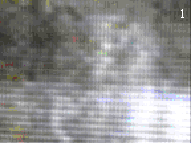 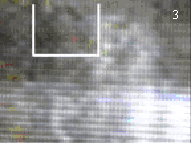 This is an example of a frame that has a major feature with an inserted feature and numerous fractal images. The insert-like feature of Image 4 (below) has been outlined in Image 3 has. This is an example of a frame that has a major feature with an inserted feature and numerous fractal images. The insert-like feature of Image 4 (below) has been outlined in Image 3 has. |
 Using editing software that came with Erland Babcock’s Toshiba PDR-M70 digital camera, the insert feature outlined in Image 3 was clipped and enhanced. You can see that the color has changed considerably; however, as things often are with EVP and ITC, the resulting color shift appears to provide a likely rendition for the man. You should be able to see a man from the chest up, wearing a black hat and a full beard. Using editing software that came with Erland Babcock’s Toshiba PDR-M70 digital camera, the insert feature outlined in Image 3 was clipped and enhanced. You can see that the color has changed considerably; however, as things often are with EVP and ITC, the resulting color shift appears to provide a likely rendition for the man. You should be able to see a man from the chest up, wearing a black hat and a full beard.
There are two points that we would like you to note in this and other examples shown on this page: hats are a common feature; the detail of the hat’s curves; and, that the inserted image does, indeed look like an inserted image with much greater detail than the surrounding video noise. |
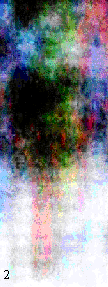  This feature appears to be a standing man wearing light-colored pants and a black blazer. He has a handlebar mustache and apparently short-cut or slicked-back hair. You can see that he is holding something in his right hand. It is hard to see in this version of the image (different photo editing software tends to highlight different features of these images), but the man has his left hand near his throat as if he has something slung over his shoulder. The picture at the right is of the famous medium Douglas Home. We believe this ITC example may be Douglas Home; however, there is of course, no way of being certain and we do not make the claim here. This feature appears to be a standing man wearing light-colored pants and a black blazer. He has a handlebar mustache and apparently short-cut or slicked-back hair. You can see that he is holding something in his right hand. It is hard to see in this version of the image (different photo editing software tends to highlight different features of these images), but the man has his left hand near his throat as if he has something slung over his shoulder. The picture at the right is of the famous medium Douglas Home. We believe this ITC example may be Douglas Home; however, there is of course, no way of being certain and we do not make the claim here.
If you look just under the white beard of the man in Image 4 above, you will see a pink to orange field of color. You cannot see it in Image 1, but if you turn Image 1, 90 degrees to the left, and focus on that pink/orange field of color, you will see that the man in Image 2 is just under the white beard of Image 4. You are welcome to download Image 1 and see for yourself. This is another example of how video ITC can show up by rotating an original frame. This may compare with the fact that some EVP are found by listening to a sound track in the reverse. |
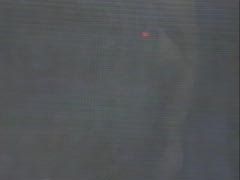  The frame to the far left is the original of this series. The second frame is the first, but enhanced to better show the detail. If you look closely, you will see a major feature that looks a little like the left side of a man’s face. The nose would be just to the right of the red dot, which is the reflection of the “Record” light of the video camera. However, we do not claim that this is a very convincing image. What we want to show you is what you see when the frame is rotated 180 degrees. This is shown in the third image of this series. The frame to the far left is the original of this series. The second frame is the first, but enhanced to better show the detail. If you look closely, you will see a major feature that looks a little like the left side of a man’s face. The nose would be just to the right of the red dot, which is the reflection of the “Record” light of the video camera. However, we do not claim that this is a very convincing image. What we want to show you is what you see when the frame is rotated 180 degrees. This is shown in the third image of this series.
This brings us to another rather interesting aspect of the ITC images we are collecting. As is shown below in Image 7 (below), we are collecting a large number of faces that seem to belong to extraterrestrials. You must be the judge of this. |
 Look closely. This looks like an extraterrestrial who is standing in front of a round window. Again, this image has been enhanced to make it clear. The original frame was nearly all black. Look closely. This looks like an extraterrestrial who is standing in front of a round window. Again, this image has been enhanced to make it clear. The original frame was nearly all black. |
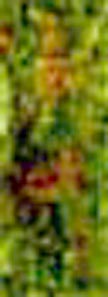 Of course, we do not know who or what this image represents. However, if you are familiar with the Irish legion of Little people and the popular New Age concepts of nature spirits, you will see that this man is very reminiscent of an elf. We see a little man mostly cloaked by green foliage. he seems to have something of a beard and mustache and is definitely wearing a domed hat with a dark brown band. We collected several such images in this ITC session conducted just before Saint Patrick’s Day. The image below was also in this session. Of course, we do not know who or what this image represents. However, if you are familiar with the Irish legion of Little people and the popular New Age concepts of nature spirits, you will see that this man is very reminiscent of an elf. We see a little man mostly cloaked by green foliage. he seems to have something of a beard and mustache and is definitely wearing a domed hat with a dark brown band. We collected several such images in this ITC session conducted just before Saint Patrick’s Day. The image below was also in this session. |
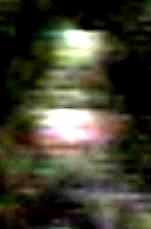 This is another ‘Elfish” feature. We will not further address the question of the Little People here, but we would like to point out a most fascinating aspect of the features we are collecting. The feature at the left appears to be that of a man who is looking to your right. He is wearing a tall hat and has a rather elongated chin. You can see his right eye rather well and most of his left. Focus your eyes until you can see this. This is another ‘Elfish” feature. We will not further address the question of the Little People here, but we would like to point out a most fascinating aspect of the features we are collecting. The feature at the left appears to be that of a man who is looking to your right. He is wearing a tall hat and has a rather elongated chin. You can see his right eye rather well and most of his left. Focus your eyes until you can see this.
Now refocus your eyes so that you can see a man looking straight at you. Most of his face is illuminated by the spot of light at the center of the image. He is wearing the same hat. The left eye of this second man is the same as the right eye of the first. Now take a good look at the man’s (men’s) hat. Do you see the face feature there? This is typical of the way face features are appearing in our ITC sessions. This is an example of an inserted feature being composed of numerous holographic or fractal features. As is shown below, we are finding face features in just about every possible arrangement of optical noise. |
 This feature was found by rotating a frame to the left 90 degrees and represents only three or four percent of the original frame. It appears to us to be a person, possibly a woman, wearing a breastplate and some kind of headdress. Obviously we cannot know for certain, but we tend to think of this person as a shaman or one of the “Little People.” This feature was found by rotating a frame to the left 90 degrees and represents only three or four percent of the original frame. It appears to us to be a person, possibly a woman, wearing a breastplate and some kind of headdress. Obviously we cannot know for certain, but we tend to think of this person as a shaman or one of the “Little People.”
If you look closely at the light area that defines the left side of the headdress, and elsewhere in the image, you can see the suggestion of holographic features. |
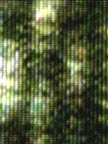  Here are two examples of holographic feature. You should be able to see at least four faces in the first image. The features are not well developed but they are obviously features that look like faces. The frame has been rotated 90 degrees to the left. It is common for us to find bands of light and dark video noise which is a product of the video feedback loop. It is also common for us to find rows of faces in these bands of lighter noise. Here are two examples of holographic feature. You should be able to see at least four faces in the first image. The features are not well developed but they are obviously features that look like faces. The frame has been rotated 90 degrees to the left. It is common for us to find bands of light and dark video noise which is a product of the video feedback loop. It is also common for us to find rows of faces in these bands of lighter noise.
The second image shows two faces that look as if they can be twins. Sometimes, we will find a row of faces that all look alike and sometimes they will be different from one another. The problem with the second image is that it could, indeed, be twins and not a holographic feature at all. |
 As we said earlier, we are collecting quite a number of people wearing hats. As with this feature, most are not particularly clear. This is offered here as a typical example. You should see a person (probably a man) looking just to your left. He has a black hat. As we said earlier, we are collecting quite a number of people wearing hats. As with this feature, most are not particularly clear. This is offered here as a typical example. You should see a person (probably a man) looking just to your left. He has a black hat. |
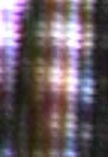 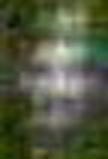 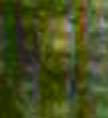 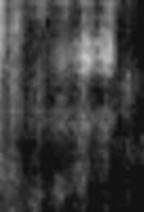  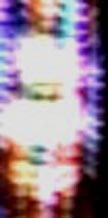
This is a sample collection of some of the faces we are collecting. The face in the second image has several holographic features, as well. It is interesting to note that the fifth face (across) seems very familiar to us. Please contact us if you think you recognize anyone in these examples. |
![]()

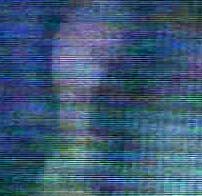 The lower lob of the “chin” in the above frames is cropped and enhanced to the left. You will see a bald head, two large eyes and an apparently determined look on a face–human or otherwise.
The lower lob of the “chin” in the above frames is cropped and enhanced to the left. You will see a bald head, two large eyes and an apparently determined look on a face–human or otherwise.
Since these discarnate people are showing us their face, which life are they revealing to us, since it’s accepted that we all live more than one life on earth, or around the universe. Are these the lives just lived, or are these personalities from previous lives? This question needs be asked, as well.
Good question, Peter.
I wrote a novel titled One Who Cares. It is based on a past life regression session I attended. The direction was to go to a lifetime in which I was successful in love. My sense is that it could have been my past experience, but it seemed more likely that I called up A past life that satisfied the direction.
That was years ago. Since then, I have come to think that the so-called life records (Akasic records) are more like thoughtforms one can attract with attention on a related experience. The personality that experienced the lifetime retains understanding it offered. In a metaphysical sense, my life experiences are likely lessor thoughtforms which are integrated by the Tom Butler attractor. When you call up Tom Butler, you get the thoughtform. (By the way, metaphysically speaking, you need not wait until the person is dead to call up their lifetime thoughtform.)
We think we recognize some of the faces, so that would be their recent lifetime. Others, like my avatar, are from centuries ago, so it would seem reasonable to guess the associated life fields have had more contemporary life experiences.
Perhaps the question of serial lifetimes needs to be addressed before we can answer your question. I argue that everywhere is here for a life field, but that time is serial. Others argue that here is everywhere and all time is now. If I am right, then the life experience represented by my avatar is probably a few lifetimes removed from its life fields present status.
Finally, there are questions as to the singularity of a life field (the core of our life experiences). We appear to be part of a collective (your collective may be different from mine). We are still trying to answer the implications of the collective concept. It may be inaccurate to say a lifetime belongs to a particular life field. It may belong to many.
From all of this, you can take that when you ask for contact with a particular person, Abraham Lincoln, for instance, you are attracting the Abraham Lincoln lifetime thoughtform and not necessarily the life field that expressed it. The same is probably true of calling up the local ghost. That is one of the reasons it may be unreasonable to ask a past life for advice. You may only be talking to the thoughtform and not the sentience that experienced it. As you say, we need to figure that one out.
Yes, more questions than answers.